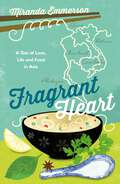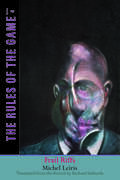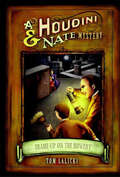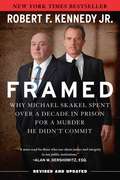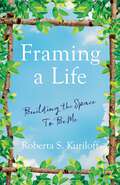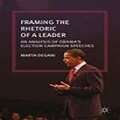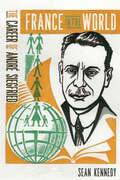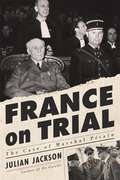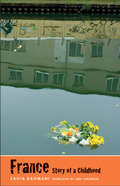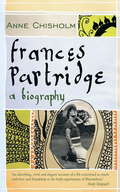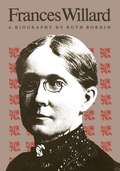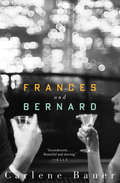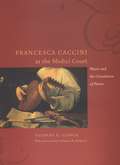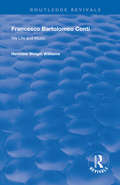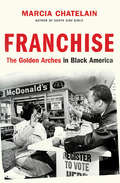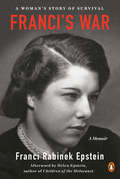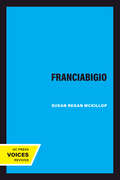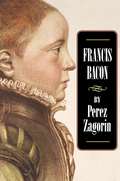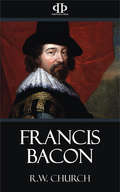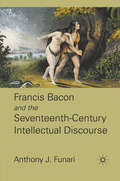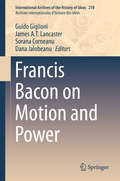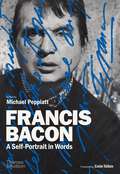- Table View
- List View
Fragrant Heart: A Tale of Love, Life and Food in South-East Asia
by Miranda EmmersonMiranda and her partner set off for one last big adventure before settling down. They chose to travel through South-East Asia. Asian flu, falling off boats and the general chaos of a life abroad challenged them at every step, yet they fell in love with the culture and culinary delights of China, Vietnam, Cambodia, Thailand and Malaysia.
Frail Riffs: The Rules of the Game, Volume 4 (The Margellos World Republic of Letters #4)
by Michel LeirisThe fourth and final volume of Michel Leiris’s renowned autobiography, now available in English for the first time, translated by Richard Sieburth Ex-surrealist and maverick anthropologist Michel Leiris (1901–1990) crafted his multivolume autobiography over the course of thirty-five years, profoundly influencing generations of French writers, from Sartre and Beauvoir to Modiano and Ernaux. In this fourth and final volume, Richard Sieburth completes the project of bringing Leiris’s monumental experiment in self-portraiture into English. With wit and playfulness, Leiris assembled a scrapbook of fragments—journal extracts, travel notes, transcriptions of dreams, poems—to document the vagaries of a life committed to the difficult marriage of poetry and revolutionary politics, which he witnessed firsthand in Mao’s China, Castro’s Cuba, and on the Paris streets in May ’68. Frail Riffs is a jazz improvisation on the twilight of a life, at once a painstaking self-examination and a chronicle of a century. As Leiris wrote, it is "neither a private diary nor a formal work, neither an autobiographical narrative nor a work of the imagination, neither prose nor poetry, but all this at the same time. . . . A perpetual work in progress.&rdquo
Frame-up on the Bowery (Houdini & Nate Mysteries)
by Tom LalickiDuring Yuletide 1911, a brutal Midtown murder shocks the denizens of New York City. After a mutual friend is wrongly accused of being the killer, young sleuth Nate Fuller, along with his famous mentor Harry Houdini, is determined to solve the case. For starters, Houdini and Nate are certain their friend has been framed. But why? By whom? And how can they save him? In their new adventure, old New York's acclaimed detecting duo brave the rough-and-tumble streets of the Lower East Side, where colorful, conniving characters abound, and the only thing certain is danger every step of the way.
Framed: Why Michael Skakel Spent Over a Decade in Prison for a Murder He Didn't Commit
by Robert F. Kennedy Jr.On Halloween, 1975, fifteen-year-old Martha Moxley’s body was found brutally murdered outside her home in swanky Greenwich, Connecticut. Twenty-seven years after her death, the State of Connecticut spent some $25 million to convict her friend and neighbor, Michael Skakel, of the murder. The trial ignited a media firestorm that transfixed the nation. Now Skakel’s cousin Robert F. Kennedy, Jr., solves the baffling whodunit and clears Michael Skakel’s name. In this revised edition, which includes developments following the Connecticut Supreme Court decision, Kennedy chronicles how Skakel was railroaded amidst a media frenzy and a colorful cast of characters—from a crooked cop and a narcissistic defense attorney to a parade of perjuring witnesses.
Framing a Life: Building the Space To Be Me
by Roberta S. KuriloffOn a blustery Maine day, thirty-nine-year-old Roberta Kuriloff found herself standing on a plot of land purchased with her former partner, holding a couple of wood stakes to mark off exactly where her new house would sit. No longer their land. No longer their dream. Now, just hers. Immersed in a world of blueprints, materials, contractors, and critters, Roberta confronted the major losses she’d suffered in her life—in particular the deaths of her mother and aunt from cancer and her separation from her father and brother during her placement in an orphanage—and to try to understand how those losses had shaped the woman, lawyer, and activist she’d become. As she cleared land, hammered nails, lifted beams, and shivered in her rented mobile home, the answers began to come to her. Roberta soon found love again, with a woman named Nancy . . . only to lose her abruptly just one year later in a car accident. Her grief over Nancy’s death, and the psychic and out-of-body events she experienced following that loss, led to an eight-year spiritual quest where she explored her Jewish roots, the Kabbalah, Buddhism, and reincarnation. As she healed, new love beckoned with Bernice—and at long last Roberta found that intrinsic sense of self, that unshakable foundation of heart and soul, that home, that she’d been searching for all along.
Framing the Rhetoric of a Leader
by Marta DeganiBased on a selection of 30 election campaign speeches during Obama's first run for the American presidency in 2008, this book investigates the Democratic presidential candidate's much celebrated rhetoric from a cognitive semantics point of view.
France in the World: The Career of André Siegfried
by Sean M. KennedyAndré Siegfried (1875–1959) was a leading figure in French academic and cultural life for over five decades. A world traveller who trained as a geographer, Siegfried became a leading political scientist and prominent newspaper columnist. As a long-time professor at Sciences Po, he shaped generations of his country’s elite. France in the World explores the life and career of André Siegfried. An innovator in the field of political science, he established himself as France’s leading interpreter of the English-speaking world. Often likened to Alexis de Tocqueville, Siegfried published influential studies of the United States, Canada, Great Britain, and New Zealand, striving to understand France’s place in a changing global context. Siegfried was a cosmopolitan promoter of liberalism and individual freedom. But at the same time he perceived France to be the core of a Western civilization whose leadership and values were threatened by Americanization, anti-imperial nationalism, and non-white immigration. By following Siegfried’s long career and examining the breadth of his writings, Sean Kennedy shows how his racial and ethnic essentialism was a unifying aspect of his life’s work. That these ideas were considered unremarkable for most of his lifetime offers a powerful illustration of how racist thinking permeated mainstream French republicanism.Exploring the many facets of Siegfried’s career, France in the World examines the entanglement of liberal and racist thinking during an era that witnessed political extremism and a rapidly changing international order.
France on Trial: The Case of Marshal Pétain
by Julian JacksonFor three weeks in July 1945 all eyes were fixed on a humid Paris, where France’s disgraced former head of state was on trial, accused of masterminding a plot to overthrow democracy. Would Philippe Pétain, hero of Verdun, be condemned as the traitor of Vichy?In the terrible month of October 1940, few things were more shocking than the sight of Marshal Philippe Pétain—supremely decorated hero of the First World War, now head of the French government—shaking hands with Hitler. Pausing to look at the cameras, Pétain announced that France would henceforth collaborate with Germany. “This is my policy,” he intoned. “My ministers are responsible to me. It is I alone who will be judged by History.”Five years later, in July 1945, after a wave of violent reprisals following the liberation of Paris, Pétain was put on trial for his conduct during the war. He stood accused of treason, charged with heading a conspiracy to destroy France’s democratic government and collaborating with Nazi Germany. The defense claimed he had sacrificed his personal honor to save France and insisted he had shielded the French people from the full scope of Nazi repression. Former resisters called for the death penalty, but many identified with this conservative military hero who had promised peace with dignity.The award-winning author of a landmark biography of Charles de Gaulle, Julian Jackson uses Pétain’s three-week trial as a lens through which to examine one of history’s great moral dilemmas. Was the policy of collaboration “four years to erase from our history,” as the prosecution claimed? Or was it, as conservative politicians insist to this day, a sacrifice that placed pragmatism above moral purity? As head of the Vichy regime, Pétain became the lightning rod for collective guilt and retribution. But he has also been an icon of the nationalist right ever since. In France on Trial, Jackson blends courtroom drama, political intrigue, and brilliant narrative history to highlight the hard choices and moral compromises leaders make in times of war.
France, Story of a Childhood
by Lara Vergnaud Zahia RahmaniThis moving tale of imprisonment and escape, persecution and loss, is narrated by the daughter of an alleged Harki, an Algerian soldier who fought for the French during the Algerian War for Independence. It was the fate of such men to be twice exiled, first in their homeland after the war, and later in France, where fleeing Harki families sought refuge but instead faced contempt, discrimination, and exclusion. Zahia Rahmani blends reality and imagination in her writing, offering a fictionalized version of her own family's struggle. Lara Vergnaud's beautiful translation from the French perfectly captures the voices and emotions of Rahmani's childhood in a foreign land. While the author delves deeply into the past, she also indicts present-day France and Algeria. From the unique perspective of the daughter of an accused Harki, she examines France's complex and controversial history with its former colony and offers new insight into the French civil riots of 2005. She makes a stirring plea for understanding between generations and cultures, and especially for an end to the destructive practice of condemning children for their fathers' actions and beliefs.
Frances Partridge: The Biography
by Anne ChisholmFrances Partridge: the last survivor of the Bloomsbury group - the authorised biography.Frances Partridge was one of the great British diarists of the 20th century. She became part of the Bloomsbury group encountering Virginia Woolf, Lytton Strachey, the Bells, Roger Fry, Maynard Keynes, Dora Carrington and Ralph Partridge. She and Ralph fell in love and married in 1933. During the Second World War they were committed pacifists and they enjoyed the happiest times of their lives together, entertaining friends such as E.M. Forster, Robert Kee and Duncan Grant.Despite losing both her husband and son, Frances maintained an astonishing appetite for life, whether for her friends, travelling, botany, or music. Her diaries (which she continued to write until her death in 2004) chronicle her life from the 1930s onwards. Their publication brought her recognition and acclaim, and earned her the right to be seen not as a minor character on the Bloomsbury stage but standing at the centre of her own.
Frances Partridge: The Biography
by Anne ChisholmFrances Partridge: the last survivor of the Bloomsbury group - the authorised biography.Frances Partridge was one of the great British diarists of the 20th century. She became part of the Bloomsbury group encountering Virginia Woolf, Lytton Strachey, the Bells, Roger Fry, Maynard Keynes, Dora Carrington and Ralph Partridge. She and Ralph fell in love and married in 1933. During the Second World War they were committed pacifists and they enjoyed the happiest times of their lives together, entertaining friends such as E.M. Forster, Robert Kee and Duncan Grant.Despite losing both her husband and son, Frances maintained an astonishing appetite for life, whether for her friends, travelling, botany, or music. Her diaries (which she continued to write until her death in 2004) chronicle her life from the 1930s onwards. Their publication brought her recognition and acclaim, and earned her the right to be seen not as a minor character on the Bloomsbury stage but standing at the centre of her own.
Frances Willard
by Ruth BordinFrances Willard (1839-98), national president of the WCTU, headed the first mass organization of American women, and through the work of this group, women were able to move into public life by 1900. Willard inspired this process by her skillful leadership, her broad social vision, and her traditional womanly virtues. Although a political maverick, she won the support of the white middle class because she did not appear to challenge society's accepted ideals.
Frances and Bernard
by Carlene BauerA &“dazzling and gorgeously written&” novel of art, faith, and life-changing friendship inspired by the correspondence of Flannery O&’Connor and Robert Lowell (Ann Packer). In the summer of 1957, two writers are immersed in their craft at an artist&’s colony nestled in upstate New York when chance brings them together. Frances, a country northerner, as committed to her solitude as she is her faith, and Bernard, a gregarious Bostonian with a propensity towards mania and grand gestures, find themselves forming a friendship, and then a courtship, as they each discover a kindred spirit beneath the obvious differences between them. But, as they become inexorably entwined in each other&’s lives, they struggle with the dependence of their romance and the conflict it causes with their own dreams. Inspired by the lives of Flannery O&’Connor and Robert Lowell, who formed an unlikely connection after meeting at Yaddo in the late fifties, and told in a series of intimate letters between the protagonists, Frances and Bernard is a touching and bittersweet look at what happens when love, desire, hope, faith, and friendship collide. &“Recalling 20th-century masters like Graham Greene and Walker Percy . . . Bauer is herself a distinctive stylist who can write about Simone Weil or Kierkegaard with wit and charm.&” —The New York Times Book Review &“Engrossing . . . Funny, sweet and sad. A lovely surprise.&” —Publishers Weekly, starred review &“A novel of stunning subtlety, grace, and depth . . . compos[ed in] dueling letters of breathtaking wit, seduction, and heartbreak.&” —Booklist, starred review
Francesca Caccini at the Medici Court
by Catharine R. Stimpson Suzanne G. CusickA contemporary of Shakespeare and Monteverdi, and a colleague of Galileo and Artemisia Gentileschi at the Medici court, Francesca Caccini was a dominant musical figure there for thirty years. Dazzling listeners with the transformative power of her performances and the sparkling wit of the music she composed for more than a dozen court theatricals, Caccini is best remembered today as the first woman to have composed opera. Francesca Caccini at the Medici Court reveals for the first time how this multitalented composer established a fully professional musical career at a time when virtually no other women were able to achieve comparable success. Suzanne G. Cusick argues that Caccini's career depended on the usefulness of her talents to the political agenda of Grand Duchess Christine de Lorraine, Tuscany's de facto regent from 1606 to 1636. Drawing on Classical and feminist theory, Cusick shows how the music Caccini made for the Medici court sustained the culture that enabled Christine's power, thereby also supporting the sexual and political aims of its women. In bringing Caccini's surprising story so vividly to life, Cusick ultimately illuminates how music making functioned in early modern Italy as a significant medium for the circulation of power.
Francesca Caccini at the Medici Court: Music and the Circulation of Power (Women In Culture And Society Ser.)
by Suzanne G. CusickA &“priceless&” study of the life and career of the Renaissance-era Italian who was the first woman to have composed an opera (Gender & History).&“Extraordinary in its breadth, its detail, its insight, and its worth to all participants in early music…. Its contribution is not limited to the musical world, however, as Cusick&’s remarkable command and analysis of her material…has immense value for scholars engaged in cultural studies, performance studies, history, politics, or the study of difference.&”—Renaissance Quarterly A contemporary of Shakespeare and Monteverdi, and a colleague of Galileo and Artemisia Gentileschi at the Medici court, Francesca Caccini was a dominant musical figure there for thirty years. Dazzling listeners with the transformative power of her performances and the sparkling wit of the music she composed for more than a dozen court theatricals, Caccini is best remembered today as the first woman to have composed opera. Francesca Caccini at the Medici Court reveals for the first time how this multitalented composer established a fully professional musical career at a time when virtually no other women were able to achieve comparable success. Suzanne G. Cusick argues that Caccini&’s career depended on the usefulness of her talents to the political agenda of Grand Duchess Christine de Lorraine, Tuscany&’s de facto regent from 1606 to 1636. Drawing on Classical and feminist theory, Cusick shows how the music Caccini made for the Medici court sustained the culture that enabled Christine&’s power, thereby also supporting the sexual and political aims of its women. In bringing Caccini&’s surprising story so vividly to life, Cusick ultimately illuminates how music making functioned in early modern Italy as a significant medium for the circulation of power.
Francesco Bartolomeo Conti: His Life and Music (Routledge Revivals)
by Hermine Weigel WilliamsFirst Published in 1999, Hermine Weigel Williams’ study draws on more than thirty years of research to fill this noticeable lacuna , and presents here the first full scale life and works of the composer for over ninety years. Part One of the book surveys the biographical aspects of Conti’s career. Appointed court theorist at the age of nineteen, Conti was promoted to court composer in 1713-14. Williams examines Conti’s creative collaborations with some of the leading poet-librettists of the day, and the influence of his music that can be identified in works by Telemann, Bach and Handel. Part Two comprises close analyses of Conti’s compositions: his instrumental music, cantatas, operas, intermezzos, oratorios and sacred music. Williams reveals Conti as a composer who constantly experimented with a wide range of French, German and Italian ideas and techniques to create his own diverse musico-dramatic style.
Franchise: The Golden Arches In Black America
by Marcia ChatelainFrom civil rights to Ferguson, Franchise reveals the untold history of how fast food became one of the greatest generators of black wealth in America. Often blamed for the rising rates of obesity and diabetes among black Americans, fast food restaurants like McDonald’s have long symbolized capitalism’s villainous effects on our nation’s most vulnerable communities. But how did fast food restaurants so thoroughly saturate black neighborhoods in the first place? In Franchise, acclaimed historian Marcia Chatelain uncovers a surprising history of cooperation among fast food companies, black capitalists, and civil rights leaders, who—in the troubled years after King’s assassination—believed they found an economic answer to the problem of racial inequality. With the discourse of social welfare all but evaporated, federal programs under presidents Johnson and Nixon promoted a new vision for racial justice: that the franchising of fast food restaurants, by black citizens in their own neighborhoods, could finally improve the quality of black life. Synthesizing years of research, Franchise tells a troubling success story of an industry that blossomed the very moment a freedom movement began to whither.
Franci's War: A Woman's Story of Survival
by Franci Rabinek EpsteinThe engrossing memoir of a spirited and glamorous young fashion designer who survived World War ll, with an afterword by her daughter, Helen Epstein.In the summer of 1942, twenty-two year-old Franci Rabinek--designated a Jew by the Nazi racial laws--arrived at Terezin, a concentration camp and ghetto forty miles north of her home in Prague. It would be the beginning of her three-year journey from Terezin to the Czech family camp in Auschwitz-Birkenau, to the slave labor camps in Hamburg, and Bergen Belsen. After liberation by the British in April 1945, she finally returned to Prague.Franci was known in her group as the Prague dress designer who lied to Dr. Mengele at an Auschwitz selection, saying she was an electrician, an occupation that both endangered and saved her life. In this memoir, she offers her intense, candid, and sometimes funny account of those dark years, with the women prisoners in her tight-knit circle of friends.Franci's War is the powerful testimony of one incredibly strong young woman who endured the horrors of the Holocaust and survived.
Franciabigio (California Studies in the History of Art #16)
by Susan Regan McKillopThis title is part of UC Press's Voices Revived program, which commemorates University of California Press’s mission to seek out and cultivate the brightest minds and give them voice, reach, and impact. Drawing on a backlist dating to 1893, Voices Revived makes high-quality, peer-reviewed scholarship accessible once again using print-on-demand technology. This title was originally published in 1974.
Francis Bacon
by Perez ZagorinFrancis Bacon (1561-1626), commonly regarded as one of the founders of the Scientific Revolution, exerted a powerful influence on the intellectual development of the modern world. He also led a remarkably varied and dramatic life as a philosopher, writer, lawyer, courtier, and statesman. Although there has been much recent scholarship on individual aspects of Bacon's career, Perez Zagorin's is the first work in many years to present a comprehensive account of the entire sweep of his thought and its enduring influence. Combining keen scholarly and psychological insights, Zagorin reveals Bacon as a man of genius, deep paradoxes, and pronounced flaws. The book begins by sketching Bacon's complex personality and troubled public career. Zagorin shows that, despite his idealistic philosophy and rare intellectual gifts, Bacon's political life was marked by continual careerism in his efforts to achieve advancement. He follows Bacon's rise at court and describes his removal from his office as England's highest judge for taking bribes. Zagorin then examines Bacon's philosophy and theory of science in connection with his project for the promotion of scientific progress, which he called "The Great Instauration." He shows how Bacon's critical empiricism and attempt to develop a new method of discovery made a seminal contribution to the growth of science. He demonstrates Bacon's historic importance as a prophetic thinker, who, at the edge of the modern era, predicted that science would be used to prolong life, cure diseases, invent new materials, and create new weapons of destruction. Finally, the book examines Bacon's writings on such subjects as morals, politics, language, rhetoric, law, and history. Zagorin shows that Bacon was one of the great legal theorists of his day, an influential philosopher of language, and a penetrating historian. Clearly and beautifully written, the book brings out the richness, scope, and greatness of Bacon's work and draws together the many, colorful threads of an extraordinarily brilliant and many-sided mind.
Francis Bacon
by R. W. ChurchThe life of Francis Bacon is one which it is a pain to write or to read. It is the life of a man endowed with as rare a combination of noble gifts as ever was bestowed on a human intellect; the life of one with whom the whole purpose of living and of every day's work was to do great things to enlighten and elevate his race, to enrich it with new powers, to lay up in store for all ages to come a source of blessings which should never fail or dry up; it was the life of a man who had high thoughts of the ends and methods of law and government, and with whom the general and public good was regarded as the standard by which the use of public power was to be measured; the life of a man who had struggled hard and successfully for the material prosperity and opulence which makes work easy and gives a man room and force for carrying out his purposes.
Francis Bacon and the Modern Dilemma
by Loren C. EiseleyA critical examination of Francis Bacon, the scientist and educator who founded the scientific method that is used even today to deduce the answer to a given problem.
Francis Bacon and the Seventeenth-Century Intellectual Discourse
by Anthony J. FunariThis book explores the resistance of three English poets to Francis Bacon's project to restore humanity to Adamic mastery over nature, moving beyond a discussion of the tension between Bacon and these poetic voices to suggest theywere also debating the narrative of humanity's intellectual path.
Francis Bacon on Motion and Power
by Sorana Corneanu Guido Giglioni James A.T. Lancaster Dana JalobeanuThis book offers a comprehensive and unitary study of the philosophy of Francis Bacon, with special emphasis on the medical, ethical and political aspects of his thought. It presents an original interpretation focused on the material conditions of nature and human life. In particular, coverage in the book is organized around the unifying theme of Bacon's notion of appetite, which is considered in its natural, ethical, medical and political meanings. The book redefines the notions of experience and experiment in Bacon's philosophy of nature, shows the important presence of Stoic themes in his work as well as provides an original discussion of the relationships between natural magic, prudence and political realism in his philosophy. Bringing together scholarly expertise from the history of philosophy, the history of science and the history of literature, this book presents readers with a rich and diverse contextualization of Bacon's philosophy.
Francis Bacon: A Self-portrait In Words
by Michael PeppiattA new selection of letters, statements, and interviews reveals the preoccupations, thoughts, and ideas of Francis Bacon, one of the twentieth century’s most influential and important artists. The documents selected for Francis Bacon: A Self-Portrait in Words illustrate Bacon’s sharp wit and ability to express complex ideas in highly personal, memorable language. Included here are not only letters to friends, patrons, and fellow artists, but also intriguing notes and lists of paintings. They often come with a sketch as an aide-mémoire or an injunction to himself as he worked in the studio, and many have only come to light since his death. Bacon's letters mirror and reveal his dominant preoccupations at different points throughout his long career. Most of Bacon's letters have never been published and include several that he wrote to author Michael Peppiatt. Particularly intriguing is the record of a dream that he jotted down, outlining impossibly beautiful paintings he had conjured up in his sleep. Together with photographs, archive material, and works by the artist are numerous reproductions of Bacon's characteristic handwriting, from the briefest jottings and notes to more extensive letters and statements. Bacon frequently came up with memorable epithets and definitions. He delighted in doing with words what he set out to do in painting: "I like phrases that cut me." Peppiatt explores the personal legacy of one of the twentieth century's most important painters and presents a compelling verbal self-portrait that reveals both man and artist.
